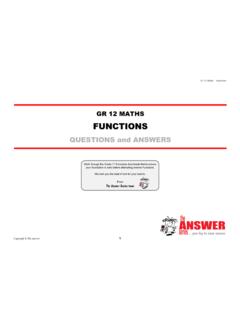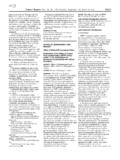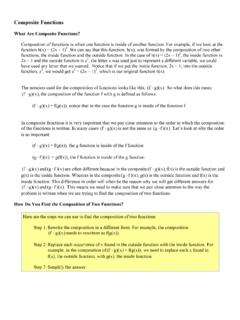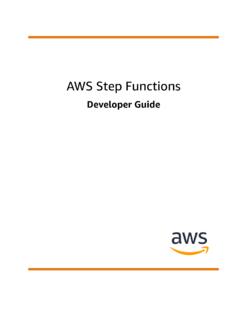Transcription of SUGI 30 Tutorials - SAS
1 Paper 233-30 An Introduction to SAS Character functions (Including Some New SAS 9 functions ) Ronald Cody, Introduction SAS software is especially rich in its assortment of functions that deal with character data. This class of functions is sometimes called STRING functions . With over 30 new character functions in Version 9, the power of SAS to manipulate character data is even more impressive. Some of the functions we will discuss are: LENGTH, SUBSTR, COMPBL, COMPRESS, VERIFY, INPUT, PUT, TRANWRD, SCAN, TRIM, UPCASE, LOWCASE, || (concatenation), INDEX, INDEXC, AND SPEDIS.
2 Some of the new and exciting Version 9 functions that we will cover are the "ANY' and "NOT" functions , the concatenation functions (and call routines), COMPARE, INDEXW, LENGTHC, PROPCASE, STRIP, COUNT, and COUNTC. How Lengths of Character Variables are Set in a SAS Data Step Before we actually discuss these functions , we need to understand how SAS software assigns storage lengths to character variables. It is important to remember two things: 1) The storage length of a character variable is set at compile time.
3 And 2) this length is determined by the first appearance of a character variable in a DATA step. There are several ways to check the storage length of character variables in your SAS data set. One way is to run PROC CONTENTS. Another is to use the SAS Explorer window and select "view columns." If you are using Version 9 and above, the new function LENGTHC can be used to determine the storage length of a character variable. Look at the following program: data chars1; file print; string = 'abc'; length string $ 7; /* Does this do anything?
4 */ storage_length = lengthc(string); display = ":" || string || ":"; put storage_length=; put display=; r un; What is the storage length of STRING? Following the rules, the length is set by the assignment statement string = 'abc' which results is a storage length of 3. The LENGTH statement is ignored (however in V9, an informative note is written in the SAS log). The LENGTHC function shows the storage length of STRING to be 3 (as would output from PROC CONTENTS or the "view columns" from the SAS Explorer).
5 The || operator is the concatenation operator which joins strings together. By concatenating a colon on each side of the variable STRING, you can see if there are any leading or trailing blanks in the value. Look at the SAS output below: storage_length=3 display=:abc: What if we move the LENGTH statement before the assignment statement? data chars2; file print; length string $ 7; /* Does this do anything? */ string = 'abc'; 1 sugi 30 Tutorials storage_length = lengthc(string); display = ":" || string || ":"; put storage_length=; put display=; run; Let's look at the output again: storage_length=7 display=:abc : Notice that the storage length of STRING is now 7.
6 The DISPLAY variable clearly shows the actual value of STRING is 'abc' followed by 4 blanks. Converting Multiple Blanks to a Single Blank This example will demonstrate how to convert multiple blanks to a single blank. Suppose you have some names and addresses in a file. Some of the data entry clerks placed extra spaces between the first and last names and in the address fields. You would like to store all names and addresses with single blanks. Here is an example of how this is done: data multiple; input #1 @1 name $20.
7 #2 @1 address $30. #3 @1 city $15. @20 state $2. @25 zip $5.; name = compbl(name); address = compbl(address); city = compbl(city); datalines; Ron Cody 89 Lazy Brook Road Flemington NJ 08822 Bill Brown 28 Cathy Street North City NY 11518 ; proc print data=multiple noobs; title "Listing of Data Set MULTIPLE"; id name; var address city state zip; run; Here is the listing: Listing of Data Set MULTIPLE name address city state zip Ron Cody 89 Lazy Brook Road Flemington NJ 08822 Bill Brown 28 Cathy Street North City NY 11518 This seemingly difficult task is accomplished in a single line using the COMPBL function.
8 It COMP resses successive blanks to a single blank. How useful! 2 sugi 30 TutorialsHow to Remove Characters from a String A more general problem is to remove selected characters from a string. For example, suppose you want to remove blanks, parentheses, and dashes from a phone number that has been stored as a character value. Here comes the COMPRESS function to the rescue! The COMPRESS function can remove any number of specified characters from a character variable.
9 The program below uses the COMPRESS function twice. The first time, to remove blanks from the string; the second to remove blanks plus the other above mentioned characters. Here is the code: data phone; input phone $ 1-15; phone1 = compress(phone); phone2 = compress(phone,'(-) '); datalines; (908)235-4490 (201) 555-77 99 ; proc print data=phone noobs; title "Listing of Data Set PHONE"; run; Here is the listing: Listing of Data Set PHONE phone phone1 phone2 (908)235-4490 (908)235-4490 9082354490 (201) 555-77 99 (201)555-7799 2015557799 The variable PHONE1 has just blanks removed.
10 Notice that the COMPRESS function does not have a second argument here. When it is omitted, the COMPRESS function removes only blanks. For the variable PHONE2, the second argument of the COMPRESS function contains a list of the characters to remove: left parenthesis, blank, right parenthesis, and blank. This string is placed in single or double quotes. Remember, when you specify a list of characters to remove, blanks are no longer included unless you explicitly include a blank in the list.
















